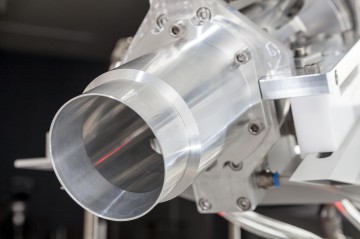
L-R: Francois Benard and Tom Ruth with a cyclotron at the BC Cancer Agency in Vancouver. Photo credit: Martin Dee
Faculty of Medicine scientists have shown that small cyclotrons – particle accelerators the size of an SUV – can replace hulking nuclear power plants as the country’s main source of medical isotopes, the radioactive atoms used for thousands of diagnostic scan across Canada each day.
The demonstration last month points the way to a safer, cleaner, more reliable and cheaper source of medical isotopes, not just in Canada, but globally. The cyclotron produced enough isotopes in six hours to enable about 500 scans – beating the previous record almost four-fold. The quantity would be enough to meet the daily needs of all of British Columbia’s hospitals.
“With this solution, we’ll be able to make completely locally-grown isotopes, without any long-term radioactive waste,” said Dr. Francois Benard, a professor of radiology and scientific director of functional imaging at the BC Cancer Agency.
The cyclotron is housed at TRIUMF, Canada’s national laboratory for particle and nuclear physics located adjacent to UBC’s Vancouver campus. The machine accelerates ions in a spiral, causing them to accumulate energy before channeling them into a beam. The beam is aimed at a plate of molybdenum-100, a naturally occurring isotope, and the resulting collisions create technetium-99m, an artificial isotope that emits gamma rays used for imaging bones, blood flow and cancers.
The breakthrough creates a viable alternative to the soon-to-be-retired National Research Universal Reactor near Chalk River, Ont., which has been the country’s main source of medical isotopes. The plant, beset by leaks, high maintenance costs and the challenge of disposing of radioactive waste, will stop making medical isotopes in 2016.
Members of UBC’s Department of Radiology have been working for five years to overcome various technical hurdles, including designing targets that can withstand very high levels of energy deposition, securely removing the irradiated material from the cyclotron, and developing efficient methods of purification. The five-year process of trial-and-error involved many re-thinks and adjustments.
Canada has about 24 cyclotrons suitable for making these isotopes, with several more expected to be put into operation in the next couple of years. Canada currently ships its isotopes from the Chalk River plant to the U.S. for packaging, then buys back the finished product.
About 4 per cent of Canadians need a diagnostic examination with technetium-99m each year. The isotopes, which only last for six hours, are typically attached to a carrier molecule and then tracked by the gamma rays they emit. The resulting images can reveal whether a cancer has spread to bones, or how well blood is flowing to the heart or brain.
Until recently, nuclear plants were able to meet the global demand for medical isotopes, and despite the cost of running reactors and the resulting radioactive waste, alternative methods were barely explored. Canada’s effort, funded by the Natural Sciences and Engineering Research Council, Natural Resources Canada and the Canadian Institutes of Health Research, was sparked by the temporary shutdown of the Chalk River plant in 2009 and the subsequent decision to close it permanently.
“The U.K, the U.S., Japan have all expressed interest in what we’re doing. Smaller countries are particularly interested, because they don’t have nuclear plants, but they do have cyclotrons that could be used for this,” said Thomas Ruth, an adjunct professor in the UBC’s department of medicine and a senior research scientist at TRIUMF. A TRIUMF-affiliated company, Applied Physics Solutions Inc., is licensing the technology for the global market.
Next steps: Dr. Benard is finalizing details of a clinical trial in Vancouver and Ontario to prove that the cyclotron-produced medical isotopes behave the same as those from nuclear reactors. The trial, expected to begin this summer and last about three months, will involve 50 to 60 patients. If the trial is a success, a cyclotron at TRIUMF would likely be dedicated to medical isotope production in B.C. – as soon as 2016.
“We’ve proven the viability of producing medical isotopes on cyclotrons,” said Paul Schaffer, an assistant professor of radiology and TRIUMF’s head of nuclear medicine. “We’re now working with Health Canada to put the solutions in place.”
